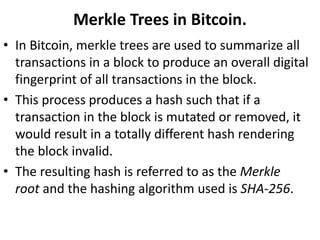Unlocking the Power of Merkle Roots: A Deep Dive into Ethereum’s Hashing Solution
When building a blockchain like Ethereum, one of the most important decisions is how to structure and verify transactions. At its core, Ethereum uses a unique hashing solution called Merkle Roots, which provide an efficient way to verify data integrity without having to store or hash every single transaction in a block. In this article, we’ll look at the benefits of using Merkle Roots over simply hashing all transactions, exploring what they accomplish and why.
What is a Merkle Root?
A Merkle Root is a digital representation of a data set that contains links (or “merkles”) to each individual piece of data within it. This process creates a hierarchical structure in which each piece of data is associated with its corresponding Merkle root, making it easier to verify the authenticity and consistency of the entire data set.
Hashing and Merkle Roots: A Comparison
Let’s compare the two approaches:
- Hashing: With hashing, each transaction in a block is stored as a unique value using a hash function. While this provides an excellent level of protection against counterfeiting, it has a major drawback: it requires storing and managing huge amounts of data.
- Merkle Roots: Using Merkle Roots provides efficient storage and verification without the need to store or hash each transaction individually. Instead, each piece of data is associated with a corresponding Merkle root, making it possible to verify the integrity of the entire data set with much less effort.
Benefits of Merkle Roots
So what are the benefits of using Merkle Roots instead of hashing all transactions in a block?
- Storage Efficiency: With Merkle Roots, only one (or fewer) Merkle Root needs to be stored, reducing storage requirements and costs.
- Enhanced Security

: By linking data to the corresponding Merkle Root, the Ethereum hashing solution becomes more resistant to tampering attempts.
- Faster Verification: The hierarchical structure of Merkle Roots provides faster verification processes, allowing transactions to be confirmed faster without the need to store or hash each individual piece of data.
Conclusion
Merkle Roots is a powerful and efficient hashing solution that offers many benefits in the context of the Ethereum blockchain architecture. By understanding how Merkle Roots work, developers can make informed decisions about their implementation, leading to more secure, scalable, and efficient systems. Whether you’re building a decentralized application or participating in the Ethereum network, leveraging the capabilities of Merkle Roots is an important step toward realizing the full potential of this innovative technology.
